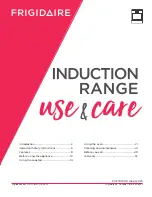
21
WARNINGS:
when the plate is switched on for the first time, or
if it has remained unused for a long period, it
should be dried for 30 minutes on switch position
n° 1. This will eliminate any moisture that may
have been absorbed by the insulating material.
To correctly use the appliance, remember:
- to place a pan on the plate before switching it on.
- To always use pans with flat and very thick
bottoms (see fig. B).
- To never use pans that are smaller than the plate
diameters.
- To dry the bottom of the pan before placing it on
the plate.
- Never leave the appliance unattended when the
plates are being used. Particularly make sure that
the pan handles are safely positioned and keep
a check on foods requiring oil and grease to
cook, since these products can easily catch fire.
- The plates will remain hot for a period of time
after use. Never touch them with the hands or
other objects in order to prevent burns.
- Immediately disconnect the appliance from the
electricity main if cracks are noted on the
surfaces of the plates.
- If the built-in hot plate has a lid, any spilt food
should be immediately removed from this
before it is opened.
- If the appliance has a glass lid, this could
shatter when the hot plate becomes hot.
Always switch off all the burners before
closing the lid.
- The appliance must not be operated with an
external timer or a separate remote-control
system.
CORRECT USE OF THE ELECTRIC PLATES
When using the electric plates, you must:
●absolutely not operate them empty (without a
container);
●try not to pour liquids on the plates when
they are hot;
●cook with a cover whenever possible to save
electricity;
●an indicator light near the knob shows when
the electric plates are turned on.
IMPORTANT:
always disconnect the appliance from the gas
and electricity mains before carrying out any
cleaning operation.
4) HOT PLATE
Periodically wash the cooktop, pan support, the
enamelled burner caps “A”, “B” and “C” and the
burner heads "T" (see fig. 6/A - 6/B) with lukewarm
soapy water. They should also be cleaned plugs
"AC" and flame detection "TC" (see fig. 6/A).
Clean them gently with a small nylon brush as
shown (see fig. 6) and allow to dry fully.
Do not wash in the dishwasher.
Following this, all parts should be thoroughly
rinsed and dried. Never wash them while they are
still warm and never use abrasive powders.
Do not allow vinegar, coffee, milk, salted water,
lemon or tomato juice from remaining in contact
with the enamelled surfaces for long periods of
time.
WARNINGS:
comply with the following instructions, before
remounting the parts:
●check that burner head slots “T” (fig. 6/A)
have not become clogged by foreign bodies.
●Check that enamelled burner cap “A”, “B”
and “C” (fig. 6/A - 6/B) have correctly
positioned on the burner head. It must be
steady.
●Do not force the taps if they are difficult open
or close. Contact the technical assistance
service for repairs.
●To keep in good condition the electric irons
should be treated with appropriate cleaning
products and prevent rust.
●Don’t use steam jets for the equipment
cleaning.
USE
CLEANING
Note:
continuous use could cause the burners to
change colour due to the high temperature.
Summary of Contents for 40212001
Page 42: ...42 8 8...
Page 44: ...2 7 A A 3 0 1 2 3 4 5 6 44...
Page 45: ...45 30 1 B 4 A B C 6 A 6 B T 6 B AC TC 6 A 6 spray T 6 A A B C 6 A 6 B...
Page 46: ...B 5 f mm 7 7 8 3 6 E 9 9 A 9 S H F S 10 70 mm top 7 46...
Page 47: ...90 C 150 C 7 20 m3 100 cm2 3 200 cm2 8 4 5 9 EN 10226 2 2 EN 10226 CE 2009 142 47...
Page 48: ...10 C 11 11 L N 90 C EMC LVD RoHS ERP 48...
Page 49: ...11 1 M 12 12 A by pass 12 D 12 C 12 A by pass G20 G30 G31 12 13 11 49...
Page 53: ...53 2002 96 EC WEEE...
Page 65: ...65 DADOS T CNICOS DA REGULA O DE G S DO APARELHO...
Page 68: ...68...
















































